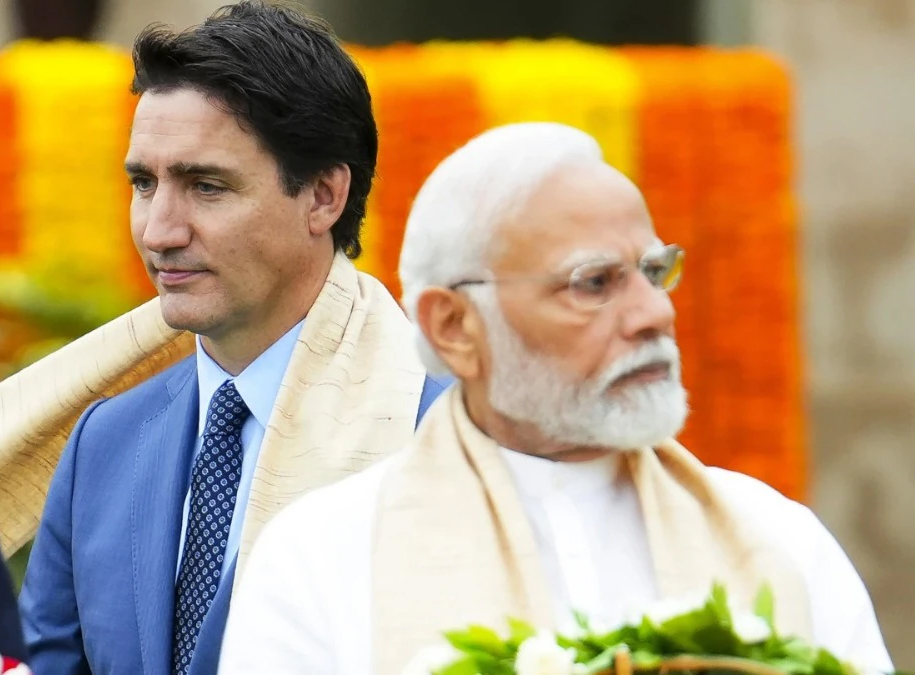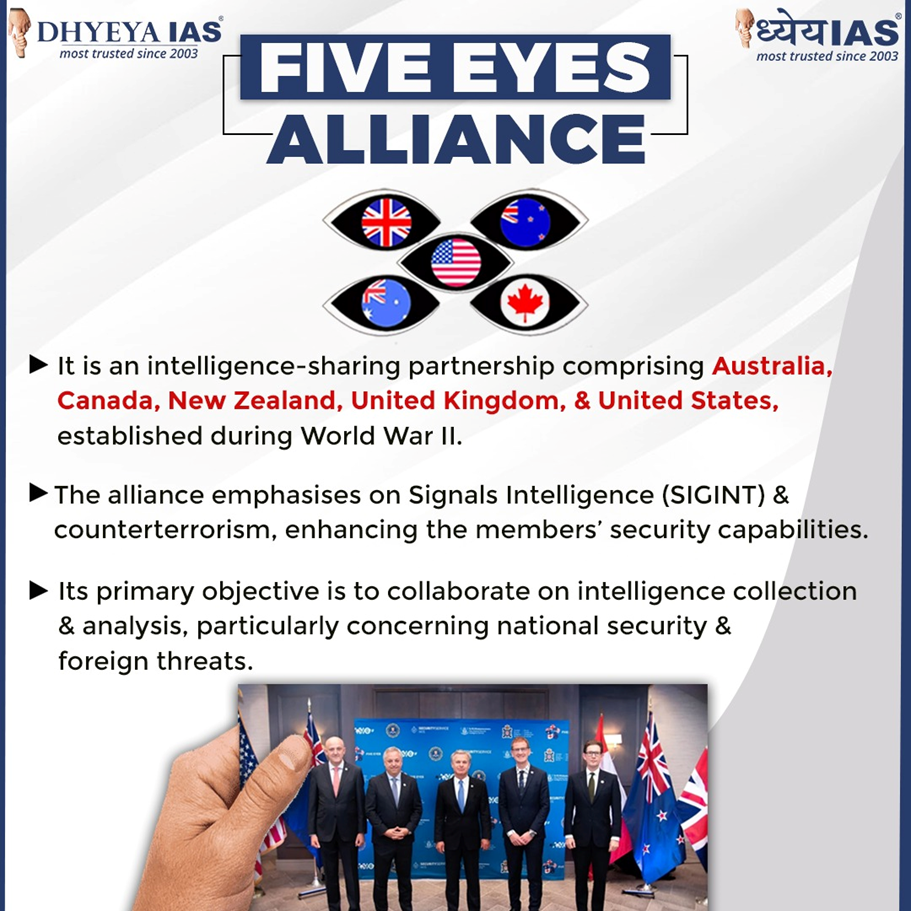Context:
Diplomatic relations between India and Canada have recently deteriorated, with both nations expelling their respective top diplomats amidst escalating tensions. The conflict was triggered by Canadian Prime Minister Justin Trudeau’s statement alleging possible links between Indian intelligence and the killing of Canadian citizen Hardeep Singh Nijjar, whom India had labeled a Khalistani terrorist. This accusation raised concerns over the growing influence of Khalistani extremism within Canada and has exacerbated geopolitical tensions with implications for India’s foreign policy, international law, and national security.
- The situation further intensified following a violent attack by a Khalistani mob on Hindu devotees at the Hindu Sabha temple in Brampton, Canada. This incident provoked a significant response from the Indian-origin community in Canada. In an unprecedented show of unity, thousands of Indian-Canadians, including both Hindus and Sikhs, took to the streets to protest the violence and express solidarity against the Khalistani elements responsible for the attack. The protests not only highlighted the community's concern over the rise of Khalistani separatism but also reflected broader fears regarding its political influence within Canada.
The Sikh Vote Bank in Canada:
- Political Influence of the Sikh Diaspora:
- The Sikh community in Canada, though a minority, wields significant political influence, particularly in Ontario.
- The Sikh vote has become crucial for political parties, especially the Liberal Party led by Prime Minister Justin Trudeau.
- Khalistan Support:
- There is a segment of the Sikh diaspora that supports the Khalistani movement, which Trudeau’s government has been accused of tolerating.
- However, the Sikh electorate is not monolithic, and many Sikh voters plan to support opposition parties, reflecting a divide on this issue.
Cultural Misunderstandings:
1. Freedom of Expression vs. India’s Sovereignty:
-
- Canada’s legal framework allows for freedom of expression and assembly, which has permitted support for the Khalistani movement.
- India, on the other hand, views the promotion of separatism as a violation of its sovereignty.
- Canada’s legal framework allows for freedom of expression and assembly, which has permitted support for the Khalistani movement.
2. Canada’s Reluctance to Condemn Extremism:
-
- India perceives Canada’s reluctance to explicitly condemn Khalistani extremism as a challenge to its territorial integrity.
- Public opinion in Canada remains divided, with younger generations often unaware of the full extent of the Khalistani movement's history.
- India perceives Canada’s reluctance to explicitly condemn Khalistani extremism as a challenge to its territorial integrity.
Legal Complexities:
- Extradition Challenges:
- India has sought the extradition of Khalistani militants from Canada, but these requests are often blocked due to human rights concerns and the evidence standard required by Canadian law.
- Barriers to Cooperation:
- Canada’s legal system does not recognize intelligence evidence gathered under Indian law, hindering cooperation on counterterrorism and national security.
- Admissibility of Evidence:
- India’s intelligence methods, such as wiretapping, do not meet Canadian legal standards for evidence, making extradition difficult.
The Role of Media:
- Media Influence in Canada:
- Canadian media has been critical of Prime Minister Trudeau’s handling of the allegations against India, questioning the evidence behind the claims.
- Media outlets have suggested that the issue may have been used as a political strategy to divert attention from other domestic challenges.
- Media in India:
- In India, media has often been polarized, with outlets aligning themselves with the government’s narrative.
- Misleading media portrayals have also contributed to a lack of clarity and understanding on both sides.
Key Cooperation Areas of India-Canada Relations:
- Political Relations:
- Both countries share democratic values, and collaborate in international forums like the G20, Commonwealth, and the United Nations to tackle global issues such as climate change, security, and development.
- Economic Cooperation:
- Bilateral trade in 2023 amounted to USD 9.36 billion.
- Canada is the 18th largest foreign investor in India, with investments of approximately USD 3.3 billion since 2000.
- Ongoing negotiations for the Comprehensive Economic Partnership Agreement (CEPA) aim to strengthen trade ties further.
- Diaspora Connections:
- Canada is home to over 1.8 million people of Indian origin, which significantly contributes to cultural exchange and economic cooperation.
- Education and Space Innovation:
- Collaborative initiatives include research in healthcare, agricultural biotechnology, and space programs like ISRO’s launches of Canadian satellites.
- Indian students represent about 40% of Canada’s international student population, enhancing cultural and academic ties.
- Nuclear Cooperation:
- A Nuclear Cooperation Agreement signed in 2010 allows the supply of uranium to India and sets up a Joint Committee for oversight.
Major Challenges in India-Canada Relations:
- Diplomatic Immunity Issue:
- Canada has invoked the Vienna Conventions, seeking protection for its diplomatic staff and citizens in India.
- India’s response to these concerns will be pivotal in determining the future course of diplomacy.
- Khalistan Issue:
- India sees Canada’s tolerance of Khalistani separatist groups as a direct threat to its territorial integrity.
- Tensions heightened following Canada’s investigation into the alleged Indian involvement in Nijjar’s assassination.
- Economic and Trade Barriers:
- Diplomatic tensions have stalled the finalization of CEPA negotiations, and trade has slowed.
- Uncertainty surrounding Canadian investments in India further complicates economic relations.
- Visa and Immigration Issues:
- Due to reduced Canadian diplomatic presence in India, visa processing delays have affected students and workers.
- The diplomatic crisis has caused disruptions in Indian nationals' ability to travel to Canada.
- Geopolitical Implications:
- The diplomatic standoff may affect India’s G20 reputation and relations with Canada’s G7 and Five Eyes allies.
- Canada’s Indo-Pacific strategy, which initially focused on India, now faces hurdles, limiting cooperation in regional security and economic matters.
|
The Vienna Convention on Diplomatic Immunity The Vienna Convention on Diplomatic Relations (1961) and the Vienna Convention on Consular Relations (1963) establish frameworks for diplomatic missions and consular officers.
|
|
Five Eyes Alliance The Five Eyes Alliance is an intelligence partnership between Australia, Canada, New Zealand, the UK, and the US, based on the UK-USA Agreement for signals intelligence.
|
The Way Forward:
- Addressing the Khalistan Issue: Active dialogue is necessary to resolve concerns related to the Indian diaspora and Khalistani separatism, ensuring mutual respect for sovereignty and legal frameworks.
- Strengthening Economic Ties: Reviving the CEPA talks could unlock potential for trade and investment in sectors such as technology, renewable energy, and infrastructure.
- Geopolitical Balance: Both nations must carefully manage their relationships with key global powers like the US, China, and Russia, ensuring a balanced approach in their foreign policy.
- Leveraging Multilateral Platforms: India and Canada should use multilateral platforms like the G7 and the Five Eyes alliance to address global challenges, such as security and climate change, while promoting shared democratic values.
Conclusion:
The India-Canada diplomatic crisis reflects the complexities of international relations, where historical grievances, political dynamics, and national security concerns converge. Both countries must engage in constructive dialogue to overcome their differences, focusing on shared values and mutual interests. By addressing the Khalistan issue, strengthening economic ties, and balancing geopolitical interests, India and Canada can rebuild a relationship based on trust, respect, and cooperation. The road to resolution will require diplomatic sensitivity, strategic foresight, and a commitment to peaceful coexistence in an increasingly interconnected world.
|
Probable questions for UPSC Mains exam: Discuss the role of the Sikh diaspora in shaping Canada’s domestic and foreign policies, particularly in the context of the Khalistani movement. How does this influence Canada's stance on the India-Canada diplomatic conflict? |









